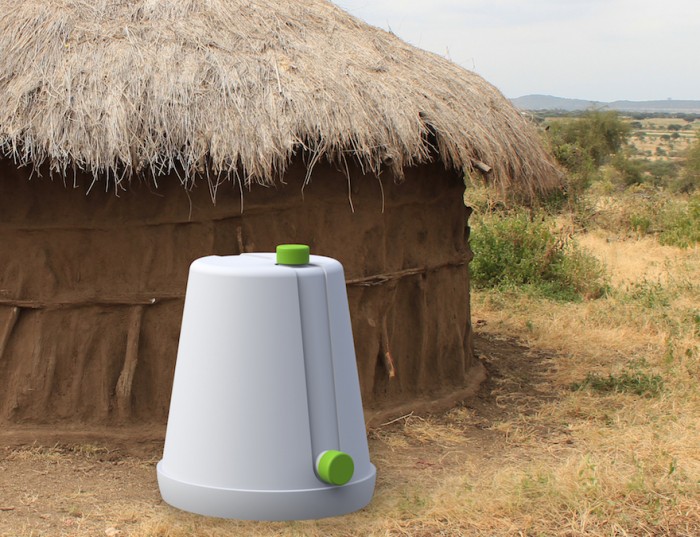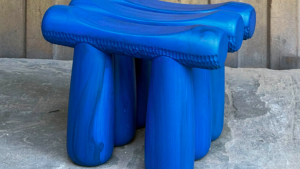
Anthony Brown, a product design student from the University of Nottingham, has been awarded an RSA Student Design Award 2016 for his Si-Low design. Si-Low is a low-cost grain storage unit to help prevent smallholder African farmers from loosing their crops after the harvest. The design was in response to the "Waste Not, Want Not" challenge, sponsored by Fazer, which called for design that helped minimise food waste. We talk to Brown about his idea.
Can you explain how your system works?
The system works by using a commonly-found principle called a hermetic seal. This means air and moisture cannot enter or leave the system, and so the grain in the Si-Low is sealed off from the atmosphere, making it last longer. The principle is very simple and is used in many applications. Where my design differs is in its ability to provide such storage for a much more affordable price so it can be used by the people who need it most.
Does it require any power?
No the Si-Low is completely power free and so does not have any running costs and can be used anywhere.
How do you build or install it?
The Si-Low would arrive in two main parts, a base and the large top part. The top part simple slots into the base and a tube of sealant is used to fix it in place and seal the gap. The inlet and outlet caps are then screwed on and the Si-Low is assembled and ready to use.
What materials does the Si-Low require?
The Si-Low is made from HDPE plastic which is rotationally moulded as one part and then cut into two main parts so that the top parts can be stacked whilst being transported. The plan is for this to occur in a rotational moulding factory in Africa, most likely in Nairobi. The stacking of parts allows for a more sustainable transport process, as it minimises the amount of resources needed.
Where did the idea come from?
My inspiration came from looking into how and where food is wasted at the beginning of the supply chain. I found that post-harvest loss is a significant issue causing waste, and it is particularly prevalent with grain in sub-Saharan Africa. A large contributor to that waste comes in the storage stage. The methods that smallholder farmers in the region use make the grain vulnerable to disease and pests. The grain often only lasts a matter of weeks and much is wasted.
I looked into what is being done about this and came across a technology called metal silos, which were launched to combat this issue. I found that whist they work well, they are not being bought or used because they cost over $200, and so the farmers that need them cannot afford them. I gave a conservative estimate of under $40 for the cost of Si-Low, but realistically it could cost $20 or lower. My solution would mean that farmers can lose far fewer crops to postharvest loss, and would allow them to sell their grain whenever they like, rather than straight after harvest when the price is lowest.
Do you intend to take this product further?
Having received some really positive feedback on the project I have felt compelled to progress the project, particularly considering the benefits it could bring. I will need all the help I can get but I am looking forward to the journey and to making Si-Low a reality. The next step is to make prototypes of the design to test its function, and also to meet with a variety of experts and organisations who will help me with progressing the project further.
What does winning the RSA Student Design Award mean to you?
Winning the RSA Student Design Award is fantastic for me, both in terms of the recognition it gave me for my hard work, and also because it will open doors for me and provide opportunities that I otherwise would not have had. The RSA has an incredible network, not least of past award winners, and I think this will play an important role in helping me with this project and also in progressing my career as a designer. To be recognised alongside some truly brilliant young designers is a real honour.
What is the role of the designer today?
The role of the designer is becoming more and more important. As the world faces a number of issues it is our duty as designers to solve problems, small or large, to make the world a better place. The modern designer is not someone who just makes things look nice, it is someone who sees solutions to a variety of complex issues. Although making things look nice is always a nice bonus.
How did you research the project? Have you tested prototypes? What kinds of questions did you ask to find out what you needed to include in the design?
My initial research was done online in order to find out more about the problem of postharvest loss and what is being done about it. After reading an article about the metal silo being launched in Tanzania to try and aid the problem, I contacted AGRA (The Alliance for a Green Revolution in Africa). From this I asked a number of questions to experts on the subject who had talked to farmers and seen the problem first-hand. I combined this with talking to experts from the Postharvest Loss Reduction Centre at the University of Greenwich, who were also extremely useful in providing information on the problem of postharvest loss and why it is still a problem.
I have yet to test prototypes because of the short-time scale I had to complete this project for my University. Testing the design using prototypes will be one of the next steps in this process.
I made sure to keep my questions quite open-ended so as to allow the experts to provide as much information as possible and to ensure nothing was missed out. A lot of the questioning revolved around the metal silos that I had discovered in my research. I wanted to understand how effective they were, if farmers were using them, and if not, why. It is from this questioning that I found that metal silos were not an effective solution, primarily due to their high cost meaning the farmers could not afford them. I also asked more specific questions, such as what capacity the silo would need to be, to this I was told by a local expert that on average Tanzanian farmers store around 500kg of grain at a time.
What or who inspires you?
Before University I probably would have struggled to answer that question as all I wanted was a degree and then a job. But since the RSA Student Design Awards my mind-set has changed completely. I am inspired by the opportunity I have as a designer to improve people’s lives through my designs. To be able to say my work has made a difference to someone’s life would be incredible and that inspires me every day.
What are your three biggest learnings from studying design - what (methodologies or philosophies) do you hope to take with you into your work always?
I would say first of all that research is key. It is far easier to design a solution when you know more about the problem you are trying to solve. Good research can identify problems and ideas that would not have otherwise been discovered. An informed designer is a better designer.
The second lesson I have learnt is to always talk to people. Designing by yourself can be lonely and ineffective. Other people have different perspectives and talking to others can really help when you feel lacking in creativity.
Lastly I would say to try and enjoy it as much as possible. Focus on areas that excite or challenge you the most. I strongly feel that enjoyment leads to a more creative mind.
The main methodology I hope to always take into my work is to get as much down on paper as possible, even if at first the idea seems far-fetched or the drawings don’t look good. Most good ideas start off in this form and I would hate to discard ideas that could have been good solutions. My main ideology I want to take into my work is to always design with the user in mind. In my mind bad design comes from designing in isolation. Incorporating the user results in a design which works far better in the real world.
For more information on the project contact Anthony Brown via email.






